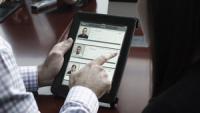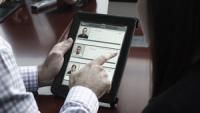-
Face Recognition Challenge seeks better face-identification software

Have you developed software to identity faces in general web photographs? Can your software verify that a face in one photograph is the same as in another? The Intelligence Advanced Research Projects Activity (IARPA) announced the launch of the Face Recognition Prize Challenge (FRPC). The challenge aims to improve biometric face recognition by improving core face recognition accuracy.
-
-
Thwarting forgery with paper fingerprints
Designing secure documents that provide high levels of security against forgery is a long-standing problem. Even in today’s digital age, this problem remains important as paper is still the most common form of proving authenticity – such as receipts, contracts, certificates and passports. Fingerprinting official documents could provide a cost-effective way to prevent forgery, new research shows.
-
-
Eye tracking technology helps in imposter detection training
Customs and Border Protection (CBP) screens nearly one million people every day and secures and manages 328 ports of entry all over the country, including in remote areas. Verifying the identity of every single person entering the United States is a vital step in halting human trafficking, drug trafficking, and other smuggling attempts at the border. In addition, security screening prevents criminals and terrorists from entering the country. Imposter detection thus crosscuts the entire Homeland Security Enterprise, as well as state, local, and tribal law enforcement and even front line soldiers in our military.
-
-
Partial fingerprints sufficient to trick biometric security systems on smartphones
No two people are believed to have identical fingerprints, but researchers have found that partial similarities between prints are common enough that the fingerprint-based security systems used in mobile phones and other electronic devices can be more vulnerable than previously thought.
-
-
Identifying faces in video images is major challenge
In movies and television, computers can quickly identify a person in a crowded arena from tiny, grainy video images. But that is often not the reality when it comes to identifying bank robbery perpetrators from security camera video, detecting terrorism suspects in a crowded railway station, or finding desired individuals when searching video archives. To advance video facial identification for these and other applications, NIST conducted a large public test known as the Face in Video Evaluation (FIVE), and the project has now released an interagency report detailing its results and aiming to provide guidance to developers of the technology.
-
-
New technology helps protect biometric databases
More and more people are leaving their fingerprints behind – in passports, when logging in to online banking or their mobile phones. Have you thought about where your fingerprint information is stored and who has access to it? Whether we store fingerprints on our mobile phone chip, with our server host or in the cloud, security is always a concern. Scientists are constantly searching for new and better security solutions to protect your information.
-
-
Aging affects the performance of automatic facial recognition systems

Images of our faces exist in numerous important databases – driver’s license, passport, law enforcement, employment – all to accurately identify us. But can these images continue to identify us as we age? Biometrics experts set out to investigate what extent facial aging affects the performance of automatic facial recognition systems and what implications it could have on successfully identifying criminals or determining when identification documents need to be renewed.
-
-
Anti-surveillance clothing blocks security cameras’ facial-recognition software
New anti-surveillance clothing has been developed, allowing wearers to prevent security cameras which use facial recognition technology from recognizing them. The clothing uses complex colored patterns of digitalized faces, and parts of faces, to overload and trick facial recognition software.
-
-
Airports post REAL ID deadline warning signs
Many U.S. airports have posted signs to alert travelers that beginning 22 January 2018, the Transportation Security Administration (TSA) will begin to enforce the REAL ID requirements at airport security checkpoints. DHS says that a year from now, passengers presenting a driver’s license or identification card from states not in compliance with the REAL ID Act’s security standards — states, that is, which have not received an extension from DHS — may not be allowed to board.
-
-
Legacy travel booking systems do not protect travelers’ private information
Travel bookings worldwide are maintained in a handful of systems. The three largest — Global Distributed Systems (GDS) Amadeus, Sabre, and Travelport — administer more than 90 percent of flight reservations as well as numerous hotel, car, and other travel bookings. The most important security feature lacking from all three GDSs is a proper way to authenticate travelers.
-
-
Robotic lie detector for border, aviation security
When you engage in international travel, you may one day find yourself face-to-face with border security that is polite, bilingual and responsive — and robotic. The Automated Virtual Agent for Truth Assessments in Real Time (AVATAR) is currently being tested in conjunction with the Canadian Border Services Agency (CBSA) to help border security agents determine whether travelers coming into Canada may have undisclosed motives for entering the country.
-
-
It is time to stop using bite marks in forensics: Experts
Forensic dentists claim that they can accurately associate a bite mark to the one and only set of teeth in the world that could have produced the crime scene bite mark. There is, however, no sound basis for believing that forensic dentists can do such a thing, and researchers are increasingly skeptical about the validity of bite-mark identification as trial evidence.
-
-
USCIS Green Card issuance problems even worse than initial findings: DHS OIG
A new DHS OIG reports says that the problems USCIS experienced in properly issuing Green Cards are worse than originally thought. USCIS produced at least 19,000 cards that included incorrect information or were issued in duplicate. Additional mistakes included over 2,400 immigrants approved for 2-year conditional residence status being inadvertently issued cards with 10-year expiration dates. The agency also received over 200,000 reports of cards potentially misdelivered, or not being delivered to approved applicants.
-
-
Images that fool computer vision raise security concerns
Computers are learning to recognize objects with near-human ability. But Cornell researchers have found that computers, like humans, can be fooled by optical illusions, which raises security concerns and opens new avenues for research in computer vision.
-
-
Half of American adults are in a little regulated police face recognition database
Half of American adults — more than 117 million people — are in a law enforcement face recognition network, according to a report. Of the fifty-two government agencies that acknowledged using face recognition, only one obtained legislative approval for its use and only one agency provided evidence that it audited officers’ face recognition searches for misuse. Not one agency required warrants, and many agencies did not even require an officer to suspect someone of committing a crime before using face recognition to identify her.
-
- All
- Regional
- Water
- Biometrics
- Borders/Immig
- Business
- Cybersecurity
- Detection
- Disasters
- Government
- Infrastructure
- International
- Public health
- Public Safety
- Communication interoperabillity
- Emergency services
- Emergency medical services
- Fire
- First response
- IEDs
- Law Enforcement
- Law Enforcement Technology
- Military technology
- Nonlethal weapons
- Nuclear weapons
- Personal protection equipment
- Police
- Notification /alert systems
- Situational awareness
- Weapons systems
- Sci-Tech
- Sector Reports
- Surveillance
- Transportation
Advertising & Marketing: advertise@newswirepubs.com
Editorial: editor@newswirepubs.com
General: info@newswirepubs.com
2010-2011 © News Wire Publications, LLC News Wire Publications, LLC
220 Old Country Road | Suite 200 | Mineola | New York | 11501
Permissions and Policies
Editorial: editor@newswirepubs.com
General: info@newswirepubs.com
2010-2011 © News Wire Publications, LLC News Wire Publications, LLC
220 Old Country Road | Suite 200 | Mineola | New York | 11501
Permissions and Policies
